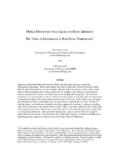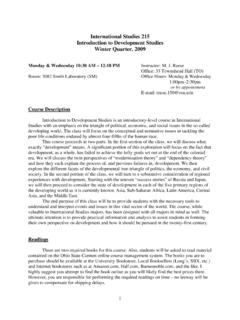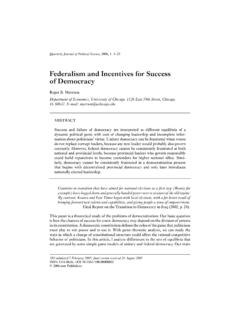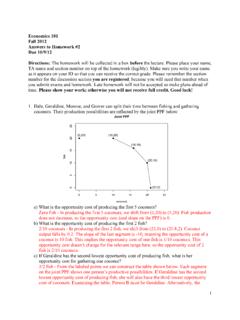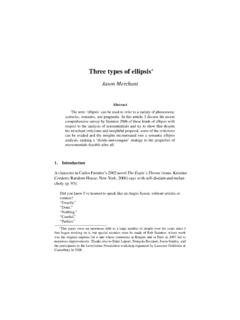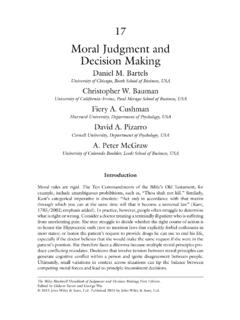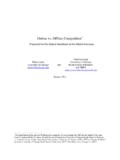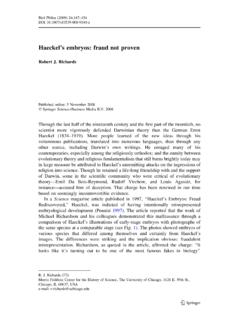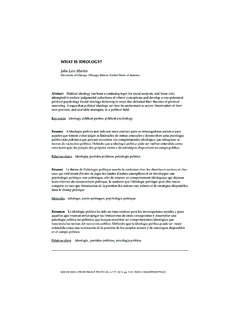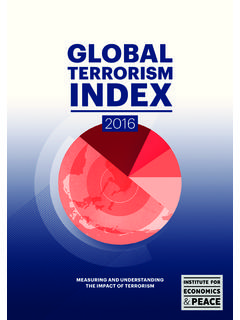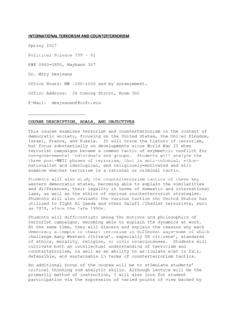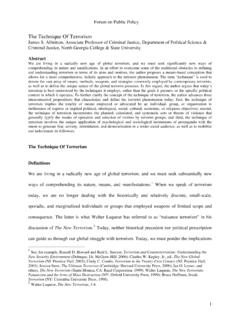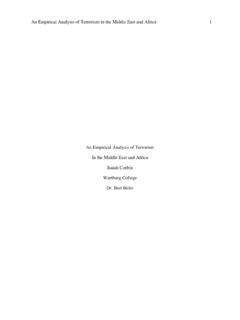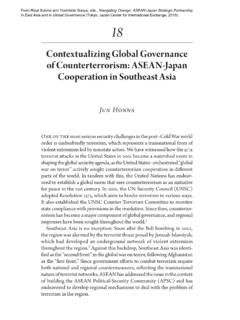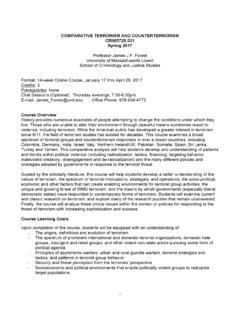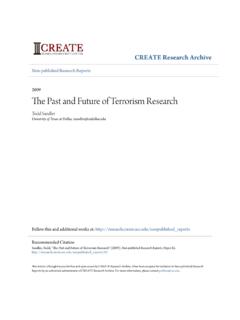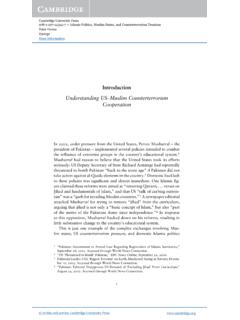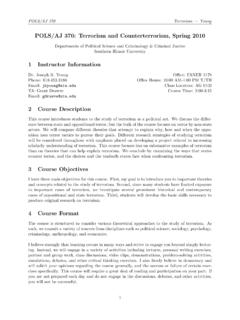Transcription of Conciliation, Counterterrorism, and Patterns of Terrorist ...
1 conciliation , counterterrorism , andPatterns of Terrorist ViolenceEthan Bueno de MesquitaAbstractWhat causes the increase in terrorism that reportedly often follows gov-ernment concessions? Given this pattern,why do governments ever conciliate terror-ists? I propose a model in which Terrorist organizations become more militant followingconcessions because only moderate terrorists accept them,leaving extremists in con-trol+Governments nonetheless are willing to make concessions because their coun-terterror capabilities improve because of the collusion of former terrorists+Formerterrorists undertake this collusion to insure the credibility of government promises+The model also yields hypotheses regarding the level of government investment incounterterror,when moderates accept concessions,the terms of negotiated settle-ments,the duration of Terrorist conflicts,incentives for moderate terrorists to radical-ize their followers.
2 And incentives for governments to encourage extremist challengesto moderate Terrorist leaders+The model is illustrated with an application to the Israeli0 Palestinian conflict+One of the most puzzling facts reported by scholars of terrorism is that thelevel of Terrorist violence often increases following government concessions+1 Forinstance,beginning in 1979,the Basque separatist group Euzkadi ta Askatasuna~ETA!engaged in a massive campaign of terror despite the fact that the newlydemocratized Spanish government granted partial autonomy to the Basque Coun-try in 1978+Between 1968 and 1977,ETA killed a total of seventy-three people+In the three years from 1978 80 there were 235 fatalities resulting from ETA ter-rorism,and for the entire 1980s and well into the 1990s the death tolls neverreturned to the relatively low levels of the 1960s to mid-1970s+2 Similarly,follow-Professor Ehud Sprinzak,who died an untimely death on November 8,2002,first introduced me tothe study of terrorism +He is greatly missed+I received valuable comments from Scott Ashworth,BobBates,Mia Bloom,Bruce Bueno de Mesquita,Charles Cohen,Eric Dickson,Amanda Friedenberg,Orit Kedar,David Lake,Macartan Humphreys,Matthew Price,Todd Sandler,Ken Shepsle,DavidAndrew Singer,Alastair Smith.
3 And Matthew Stephenson+1+For discussions of increases in violence following concessions,see Hewitt 1984;and Wilkinson1999+Further note that,although I will not engage in a lengthy definitional discussion in this article,itis important that I am describing domestic-level terror that happens more or less within the targetcountry,as opposed to transnational or international terrorism +For thorough treatments of definitionalissues in terrorism studies,see Crenshaw 1995;Gibbs 1989;Hoffman 1998;and Laqueur 1977+2+Clark 1986+International Organization59,Winter 2005,pp+145 176 2005 by The IO Foundation+DOI:10+10170S0020818305050022 ing the signing of the 1993 Oslo agreement between the Palestinians and the Israe-lis,a wave of Palestinian terror shook the Middle East,causing more fatalities inthe four years after Oslo than in thefifteen years before it+3 The infamous bomb-ing of Omagh,the most deadly attack in the past thirty years of the Troubles inNorthern Ireland,occurred on 15 August 1998,just a few months after the GoodFriday accords were signed+4 Cases such as these raise two puzzles+First,whatcauses the increased militancy that seems to follow government concessions?
4 Sec-ond,why do governments make such concessions?In this article,I present a formal model of the interactions between terroristorganizations and governments that accounts for both of these puzzles+Impor-tantly,I do not treat terror groups as unitary actors+Rather,consistent with theactual structure of most terror organizations,I assume they are composed of ideo-logically heterogeneous cells,factions,and individuals+5 Two factors drive the results+First,militancy increases following concessionsbecause it is the moderate Terrorist factions that accept concessions,leaving theextremist factions in control+Second,as has been noted by others,governmentsface a commitment problem when offering concessions to armed insurgents+6 Ter-rorists may not believe that,once they have laid down their weapons,the govern-ment will honor its promises+I explicitly model this problem and suggest anendogenous solution+Terrorists who accept concessions use their knowledge ofthe inner workings of the Terrorist organization as bargaining leverage+They do soby withholding valuable counterterrorism aid if the government reneges on con-cessions+Similarly,the government can withhold concessions if former terroristsdo not aid in counterterror+Such dynamics can be observed,for instance,in theback and forth between Israelis and Palestinians regarding the relationship betweenincreased autonomy and suppression of extremist violence+This commitment problem has two implications+First,it may be difficult for agovernment to end a conflict by offering concessions to all Terrorist factions+Thisis because such concessions are not credible in the absence of ongoing violence+Second.
5 It provides an endogenous account of why governments are willing tomake concessions despite the increased militancy they engender+The benefits ofcounterterror aid from former terrorists may outweigh the costs of heightenedmilitancy+Indeed,there are empirical cases in which governments,with the help of for-mer terrorists,have succeeded in thwarting the efforts of residual extremists+Suchcases include the destruction of the Qu bec separatist Front de Lib ration du Qu -bec~FLQ!in the 1980s,7the combined British and Hagannah efforts to preventterrorism by Zionist organizations such as the Irgun and Lohamei Herut Yisrael3+Kydd and Walter 2002+4+See Silke 1999;andThe Irish Times,12 March 2001,7+5+See Chai 1993;and Crenshaw 1981+6+See Crenshaw 2000;Fearon 1998;and Walter 1997+7+Ross 1988+146 International Organization~LEHI!in the 1940s in British-Mandate Palestine,8the Italian use of former- Terrorist informants to infiltrate left-wing Terrorist organizations,9and the crack-down on the radical Real Irish Republican Army~IRA!
6 Carried out by both thepolice and the Provisional IRA after the bombing of Omagh+10 Each of these col-lusions was undertaken in exchange for government concessions of one sort oranother+The analysis generates additional hypotheses+I allow the government to chooseits level of investment in counterterrorism endogenously and explore how boththe expected level of violence and the aid of former terrorists affects this invest-ment decision+I also discuss hypotheses regarding the terms of negotiated settle-ments between governments and terrorists,when moderates accept concessions,the effect of concessions on the duration of Terrorist conflicts,the incentives formoderate terrorists to radicalize their followers,reasons for governments to encour-age radicals within a Terrorist organization to challenge the moderate leadership,and changes in moderate control over extremists before and after negotiated set-tlement+I illustrate the model through a discussion of the conflict between Israelisand Palestinians+The Extant LiteratureOthers have noted the division between extremists and moderates+In his ground-breaking formal study of political violence,DeNardo demonstrates how govern-ment willingness to make concessions can lead to a split within a revolutionarymovement between pragmatists and purists,although he does not develop theincreased-militancy argument I present here+11 Sandler and Arce provide a modelin which government uncertainty over Terrorist types leads to adverse selection+12 Both Stedman and Kydd and Walter argue that extremists~ spoilers, in Sted-man s terminology!
7 May attempt to prevent compromise and peace by engaging interror that undermines the government s confidence in ongoing negotiations+13 Theypredict that the spoiler effect is short-term,lasting only through the period ofnegotiations+A variety of other explanations have been offered in the literature for the increasein Terrorist violence that sometimes follows government concessions+Discussingthe ETA,Shabad and Llera Ramo conclude that the cause of the increase in terrorfollowing the granting of Basque autonomy was a culture of violence that pre-8+Bell 1977+9+della Porta 1995+10+See Dingley 1999;andThe Express,6 August 2001,12+11+DeNardo 1985+12+Sandler and Arce 2003+13+See Stedman 1997;and Kydd and Walter 2002+ Conciliation, Counterterrorism, and Terrorist Violence147vented ETA from abandoning violent tactics+14 Darby argues that violence eruptsduring negotiations because of a combination of nervousness over the comingdecrease in Terrorist activity and demobilization of the security forces responsiblefor counterterror+15 Ross and Gurr suggest that violence may increase after con-cessions because compromise constitutes an existential threat to terror organiza-tions+16 Lapan and Sandler present a game-theoretic model in which they showthat,when there is uncertainty regarding a government s resoluteness.
8 The govern-ment may be concerned that concessions will lead to an increase in violence bysignaling weakness+17A fuller understanding of the politics of terrorism would incorporate all of thesefactors and many others+The model developed here does not constitute a com-plete description of the complex and nuanced politics underlying terrorism +Rather,I have attempted to isolate two important features of these politics increasedmilitancy following concessions and the commitment problem and explore theirimplications before adding additional complexity or attempting a richer theoreti-cal synthesis+The ModelConsider a model of the interaction between a Terrorist organization and a govern-ment,G+The terrorists attempt to defeat the government~for example,overthrowthe regime or force them off a piece of land!and extract concessions,while thegovernment tries to defeat the terrorists,minimize the amount of terror inflictedon society,and limit concessions+Further,the Terrorist movement is made up oftwo factions:moderates~m!
9 And extremists~e!+The game is played as follows+The government makes an offer of concessionsto the moderate Terrorist faction+These terrorists decide whether to accept thegovernment s offer or not+Accepting involves laying down weapons and comingout of hiding+Once the moderates have concluded their negotiations with the gov-ernment,the extremist faction decides whether or not to accept concessions+If aterrorist faction chooses not to accept the government s offer,it continues to engagein terror in an attempt to defeat the government+If a Terrorist faction accepts con-cessions,it becomes unable to return to terror because it demilitarizes and the gov-ernment knows its whereabouts+Factions that accept concessions must then decidewhether or not to aid the government in its counterterror efforts+The governmentsimultaneously chooses whether or not to honor promised concessions+The still-active Terrorist factions then choose a level of terror in which to engage,andfinally,the government chooses how much to invest in its counterterror program+14+Shabad and Llera Ramo 1995+15+Darby 2000+16+Ross and Gurr 1989+17+Lapan and Sandler 1988+148 International OrganizationOnce all of these decisions are made,outcomes are realized+These outcomestake two forms+First,the success of government counterterror efforts is deter-mined+If the still-active Terrorist factions survive government crackdowns.
10 Thenthe success of Terrorist violence is determined+The game is repeated until one sideor the other defeats its opponent+18 Note that although the game is infinitely repeated,there is no pure discounting of future payoffs by players+Instead,players dis-count the future based on the probabilities of entering one of the absorbing states~government or Terrorist victory!+Having described the basic outline,I now turn to the detailed assumptions under-lying the model+In roundtthe government offers concessionskt 0+I assumethat an exogenously determined fraction~b ~0,1!!of these concessions are pub-lic goods,such as a grant of political autonomy,the benefits of which are reapedby all terrorists whether or not they accept the concessions+Then~1 b!of theconcessions constitute private goods that can only be accessed by those terroristswho accept concessions+The government also attempts to eradicate the terror organization through coun-terterrorism+The government s probability of successfully defeating the terroristsis a function of two variables:the amount the government invests in counterter-rorism in roundt~at @0,Sa#!
